For a change I’m not going to write here about the latest insulin pumps, CGMs, and closed-loop systems. This is about insulin pens, and possible compatibility between some models that the manufacturers won’t tell you about.
Before I started using an insulin pump, I used injection pens for both my short-acting (“bolus”) insulin and my long-acting (“basal”). Many people using MDI (Multiple Daily Injections) therapy still do.
Pumpers use pens too!
Many people using insulin pumps buy their quick-acting insulins (e.g. Humalog or Novorapid) in 3ml pen cartridge form instead of 10ml vials. It’s just as easy to fill a pump reservoir from these as it is to use vials, and having an insulin pen on-hand allows us to have a backup option for if our pump is damaged. Similarly most pump users will still have Lantus or Levemir basal insulins in the fridge and a pen in the cupboard as part of their backup plan.
 Personally if I’m having to use an insulin pen it’s probably because I’m somewhere remote, my pump has failed, and I’ve had to switch to my backup plan. Ideally I would have a backup pump, but pumps are expensive and in fact in some environments a backup pump might not be a good idea. For example in 2017 I spent a few weeks around 4200m altitude in the Himalayas photographing snow leopards, and the particular insulin pump I was using was only certified to work at up to 3000m altitude. If the altitude caused my main pump to fail, what would be the point of having a backup pump that would meet the same fate? So I had to take pens and long-acting insulin as my backup instead.
Personally if I’m having to use an insulin pen it’s probably because I’m somewhere remote, my pump has failed, and I’ve had to switch to my backup plan. Ideally I would have a backup pump, but pumps are expensive and in fact in some environments a backup pump might not be a good idea. For example in 2017 I spent a few weeks around 4200m altitude in the Himalayas photographing snow leopards, and the particular insulin pump I was using was only certified to work at up to 3000m altitude. If the altitude caused my main pump to fail, what would be the point of having a backup pump that would meet the same fate? So I had to take pens and long-acting insulin as my backup instead.
Which pen to use?
There are basically three ranges from each of the major insulin manufacturers.
- Novo Nordisk have their Novo Pen models, which use 3ml “PenFill” cartridges loaded with Novorapid (Novolog), Fiasp, Levemir, or Tresiba insulins.
- Eli Lilly have their HumaPen models, which use 3ml cartridges (usually loaded with Humalog insulin).
- Sanofi-Aventis have their pens too, which use 3ml cartridges loaded with Apidra or Lantus insulin.
To inject the insulin we screw a disposable needle onto the end of the pen. Some pens allow you to dial up a dose to the nearest 1U, some now allow 0.5U increments. The AutoPen24 (which is compatible with Lantus, and I used for a while in the past) only allows 2U increments.
Officially each manufacturer’s pens are only compatible with their own cartridges. The Novo cartridges only fit into the Novo pens, but it turns out that the Humalog and Lantus cartridges can be swapped (with a bit of work). There are lots of provisos with this though, and that’s what I wanted to explore with this article.
It’s contrary to the manufacturer’s instructions, and is completely unsupported. But if it helps keep someone alive in an emergency, it’s useful to know about!
What about disposable pens?
 These insulins are also available in pre-filled disposable pens (usually 3 ml each). In fact the Toujeo U300 insulin is only available in this form, and that makes sense to avoid dosing errors with people accidentally injecting three times their usual dose if they were using a U100 pen. But for “normal” insulins I’ve never seen the point of disposable pens. They would take up more space in my fridge, in my travel bags, and add more rubbish to the world’s waste problem. We already generate lots of medical waste: why add to it?
These insulins are also available in pre-filled disposable pens (usually 3 ml each). In fact the Toujeo U300 insulin is only available in this form, and that makes sense to avoid dosing errors with people accidentally injecting three times their usual dose if they were using a U100 pen. But for “normal” insulins I’ve never seen the point of disposable pens. They would take up more space in my fridge, in my travel bags, and add more rubbish to the world’s waste problem. We already generate lots of medical waste: why add to it?
It’s useful to know your options
Consider the Himalayan scenario I mentioned above: if my pump failed and I had one pen for Humalog and one for Lantus, what would I do if the Humalog pen broke? I couldn’t just wait for 3 days before getting back to civilisation.
Looking into this was when I discovered that some people have been using Humalog in Sanofi ClikSTAR pens (or JuniorSTAR pens which allow 0.5U increments) because they had lots of reliability problems with the HumaPen models they could buy. This is in normal use at home, not just for emergencies. I wanted to sort out my emergency options though, so I decided to try it out.
The pens
The pens I had on hand for this exercise were a Sanofi ClikSTAR (Lantus) pen, and a Lilly HumaPen Savvio.
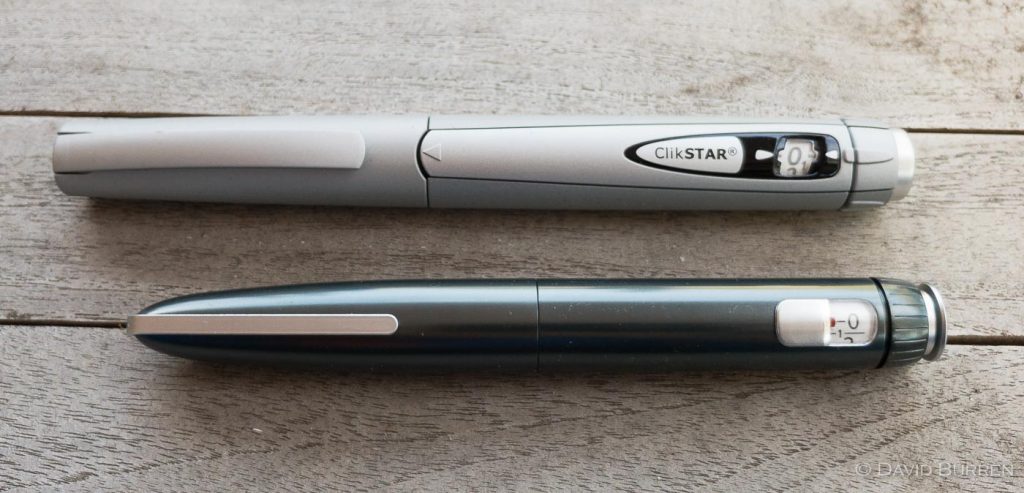
The insulin cartridges
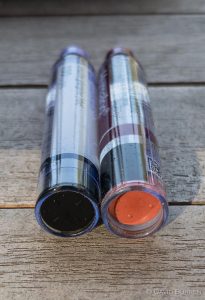 The cartridges I used contained Humalog and Lantus. The Lantus cartridge has a black plunger, while the Humalog has one more orange.
The cartridges I used contained Humalog and Lantus. The Lantus cartridge has a black plunger, while the Humalog has one more orange.
You should be able to see in this photo that the plunger for the Humalog starts a little further into the glass cartridge. But yet both cartridges apparently contain 3 ml of fluid. So what’s going on?
The other end of the Lantus cartridge is a little more tapered than the Humalog cartridge, but that’s not the only difference. Using vernier calipers I measured the internal diameter of the Lantus cartridge as 9.47 mm, while the Humalog cartridge was 9.57 mm.
The area of the Lantus plunger comes to 70.4 mm2, while the Humalog plunger is 71.9 mm2. The slightly fatter Humalog cartridge contains slightly more insulin for each mm of length. 1.02 or 2% more.
So it seems that any doses with the “wrong” insulin cartridge in the pen will be 2% off. With Humalog in a Sanofi pen the actual dose will be 98% of what you dialled up, and with Lantus in a HumaPen you will get 102% of the dialled dose.
This is not supported and is clearly “off-label” use of the medicine, and I’m not going to recommend that anyone does this as a regular thing. But if I was stuck somewhere with only one working pen, I feel confident that I would be able to survive the emergency. In fact a 2% error in the insulin dose is not likely to be noticeable.
Caveat
I have not measured the actual volumes of insulin delivered by each of these pens. My estimate of a 2% error is only derived from my observations of the internal diameter of the cartridges. But it feels like a reasonable estimate.
Do they fit?
Yes they do, with a bit of work. The Humalog cartridge drops straight into the ClikSTAR pen, and Just Works.

Fitting a Lantus cartridge into a HumaPen requires an extra step though.
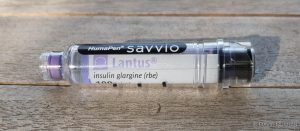
Because the Lantus plunger starts out almost at the end of the cartridge, the pen can’t be assembled with a fresh cartridge as there’s not enough room. A partly-used cartridge does fit though.
So the answer is simple: we need to waste some of the insulin in the cartridge. Carefully attaching a needle to the tip of the cartridge holder and pushing down the plunger with the needle cover does this quite easily. As you can see from the photo above of both cartridge types, we only need to push the plunger in one or two mm.
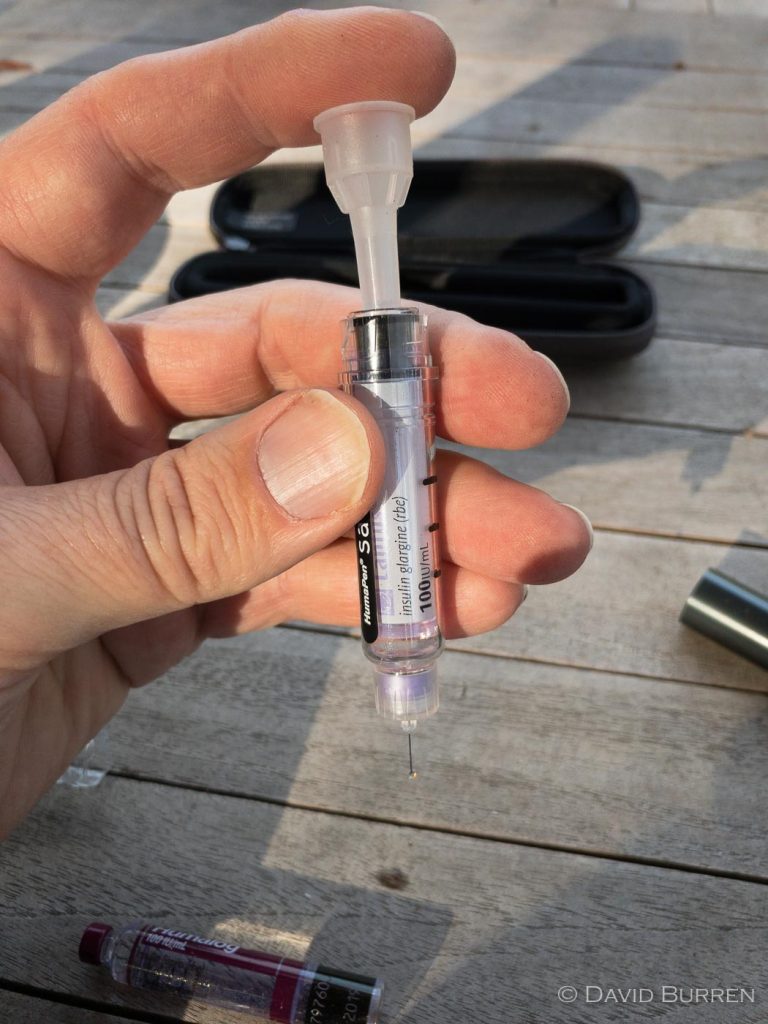
After that the pen goes together easily, and you’re able to inject your 2%-wrong dose.
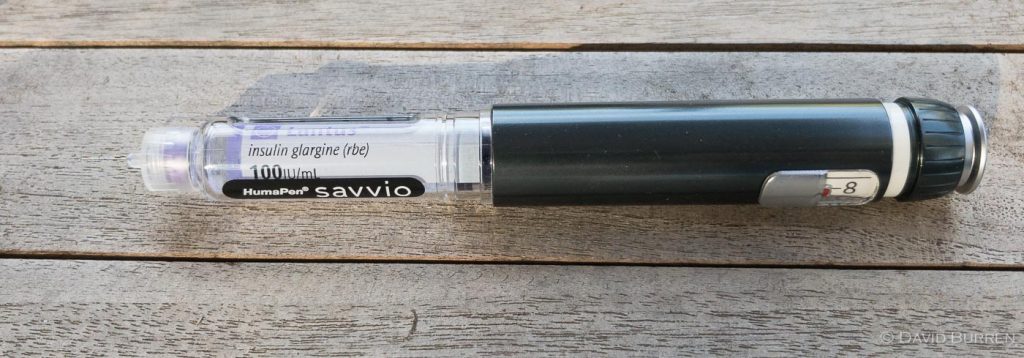
Note that Novo cartridges use a quite-different design, and are definitely not compatible with Lilly or Sanofi pens. The Novo Pens don’t allow the plunger to advance at all with a Lantus cartridge inserted, so that doesn’t work either.
Conclusion
I say again: this blog does not constitute Medical Advice!
But this trick of being able to use Lantus and Humalog pens interchangeably could one day be a useful trick to have in my kit in an emergency!

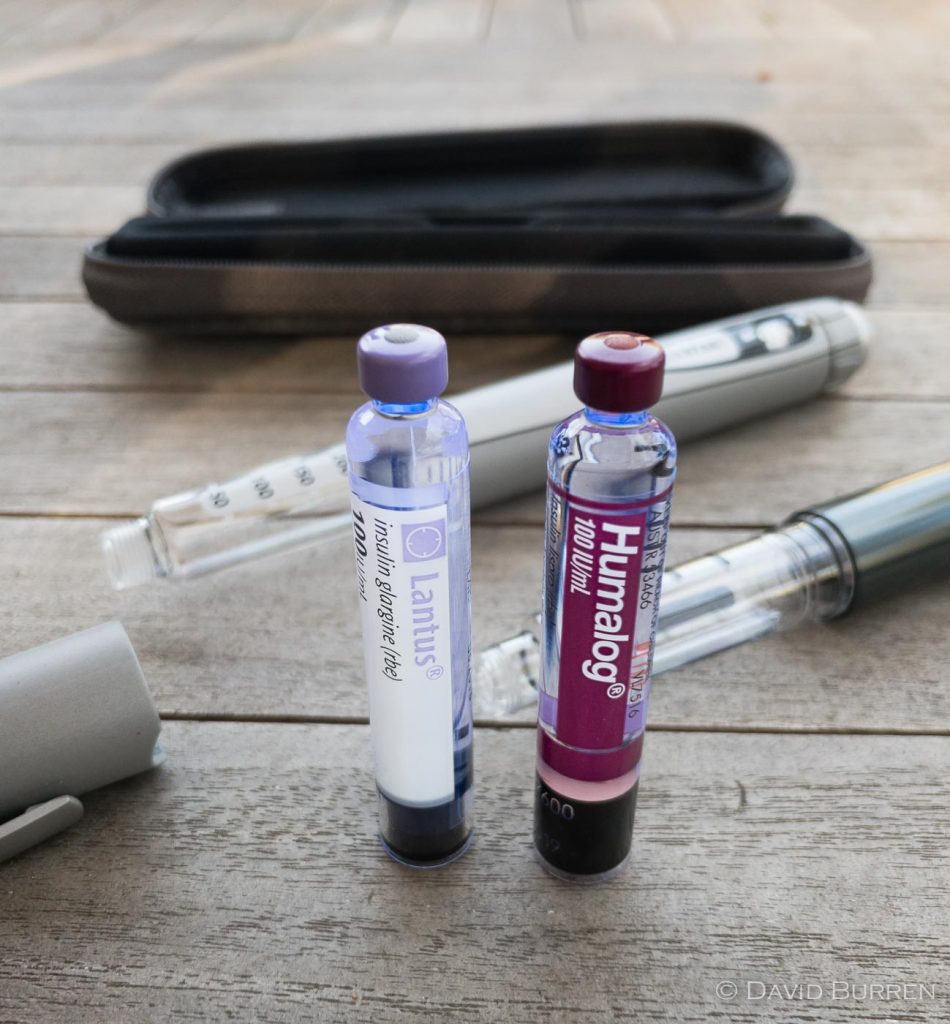
The Sanofi pen options are terrible – they’re large, ugly and lack features. The option I have been given for 0.5U doses feels laughably cheap.
I personally use Novopen Echo pens which have 0.5U and a dose memory. It boggles my mind how limited our options for reusable pens with memory are and that this is one of the only options. In fairness to Novo though, its a very good option.
The only trouble is that the Novo cartridges are yet another size again. I personally don’t like Novorapid so use Apidra which can modified to fit easily enough (they’re the same as Lantus).
In this case the dose size is increased by 6%, so if I was to take 9.5U, I would actually get 10U. This is easily compensated for by modifying carb ratios slightly and since its my only bolus insulin, it doesn’t really matter to me that the dose is slightly different – only that its repeatable.
You can turn a Sanofi into a NovoNordisk 3ml vial and use it in the Echo. Just 3 steps:
1) Adjust plastic cap: Pull plastic cap from NovoNordisk vial (apply pressure and twist with hands, be careful not to damage plastic). Place this cap on Sanofi vial.
2) Adjust width: Pull of label sticker from Sanofi vial. This reduces thickness of vial enough to place it in the Echo pen.
3) Take a coloured ring from an Oral-b electric toothbrush mouthpiece, place it at the back end of the Sanofi vial, put it in the Echo pen, close carefully. (If you skip this step, the plunger of the Echo will often move backwards when specifying the number of units, which is disastrous. The vial needs to be long enough in order to suppress this behavior. NovoNordisk vials are slightly longer than Sanofi vials.)
There will be a slight percentage difference in dose, probably in the same 2% ballpark. I am not a medical doctor, this is not medical advice. Try at own risk.
I came across this article while Lilly Humalog became not supported in pricing here in Finland. I guess their patent expired. Sanofi Lispro is the cheaper replacement. That meant I had to replace my favourite pen of all times, Lilly Luxura to this ridiculously huge Sanofi ClikStar plastic carbage. I don’t think it lasts even one year. Middle joint seems too weak as it is not threaded. I wish they had more premium reusable pen for an option.
On many pens (including some from Lilly) the two halves join together with a bayonet fitting. The ClikStar is about half-way between that and the multi-turn thread of the Luxura.
Certainly there’s a big difference in the feel and heft of the Luxura (or Luxura HD which does 0.5U increments) and the plastic ClikStar.
If you can find one, the Sanofi AllStar PRO replaced the ClikStar. It’s a little nicer, but certainly not in the same class as the Luxura pens.
Hi and thanks for your article on compatibility between Lantus and Humalog pens. I am currently seeking an emergency backup for my Novorapid pen, which I have misplaced while holidaying in the US. I can get a Humalog pen easily it seems, although for Novorapid I am struggling. But I can let you in on a little secret I previously discovered while using Lantus in the past……..
Novorapid cartridges CAN be used in a Lantus pen!!!!!
I found this out a while ago while fiddling with an empty Novorapid cartridge. The screw cap found at the end of a Novorapid cartridge which stops it advancing into a Lantus pen JUST POPS OFF with a little force, leaving an end identical to a Lantus pen underneath!
Hope this helps someone as it has helped me, because I have purchased a Humalog pen here in the US and all is now well!
I discovered by unfortunate accident that the humalog easily fits in the sanofi pen. After ~month of ever increasing morning BSLs and continuing to increase my long acting lantus dose, my insulin cartridge ran out and when I changed it, to my absolute horror, I found I had previously loaded humalog into my lantus pen and had therefore being taking massive doses of short acting insulin and obviously having major lows. I was pregnant at the time, so the insulin dose changes weren’t completely unexpected. Luckily my baby and I both survived and I sure as hell learnt my lesson.
Does Lantus Cartige fits in Novo Pen 4.
It does, although there are two things you need to do.
– Transfer the threaded plastic cap from a Novo Penfill cartridge.
– Extend the length of the cartridge (I use a plastic ring cut from a needle cover) by a few mm so the pen recognises that a cartridge is loaded.